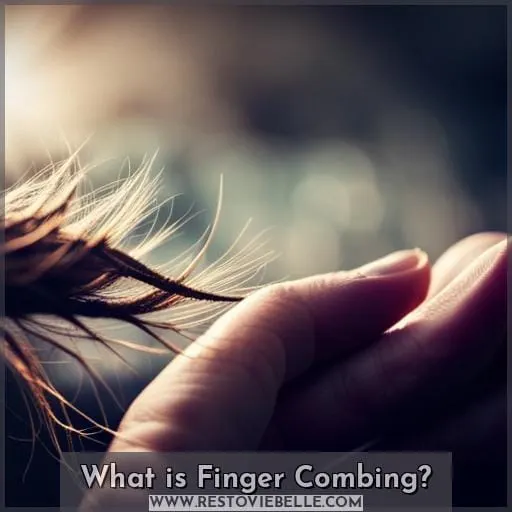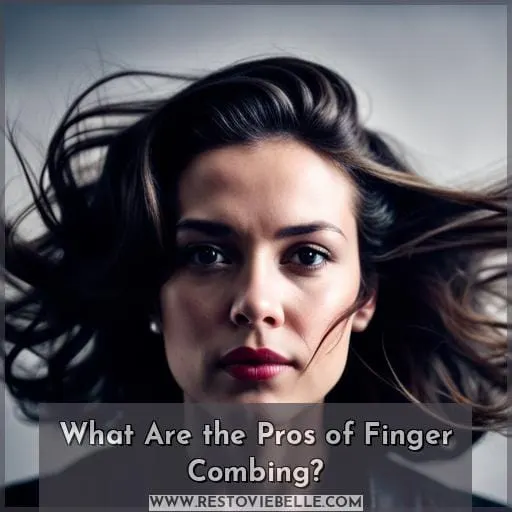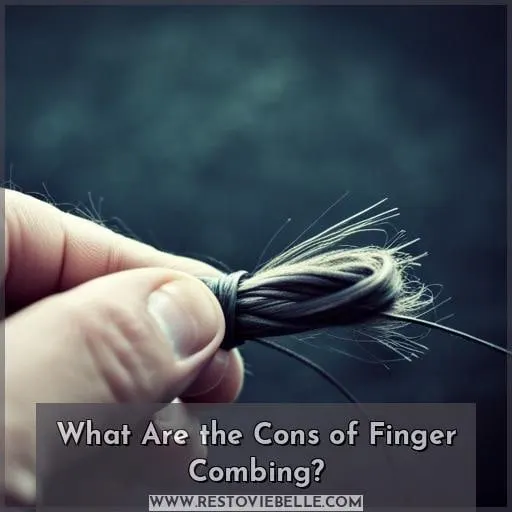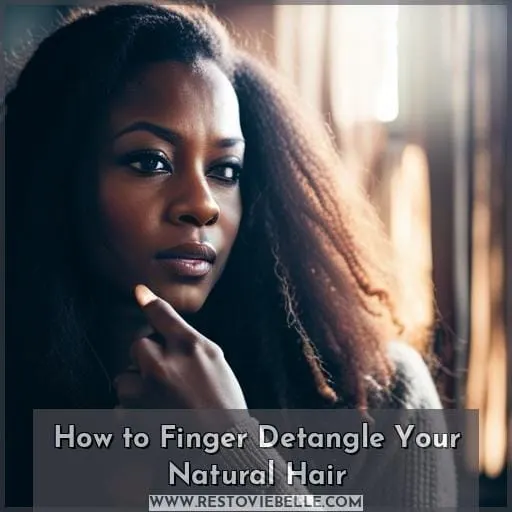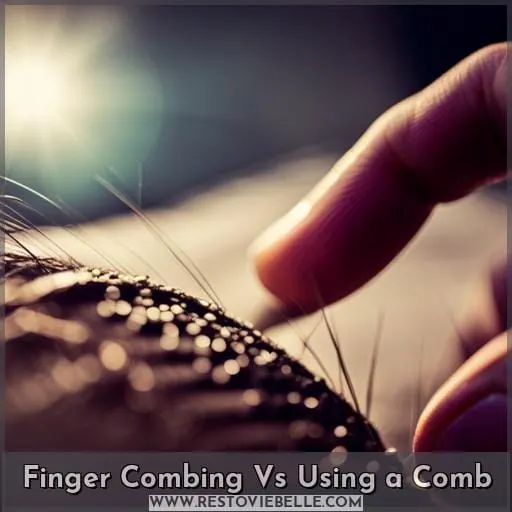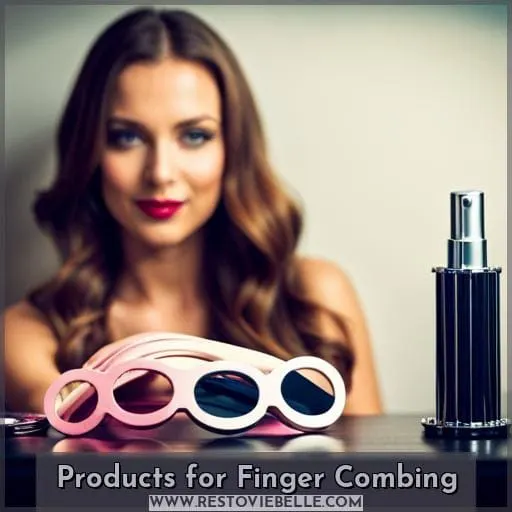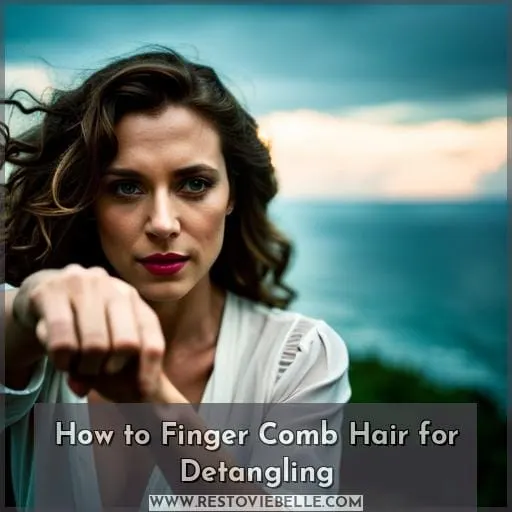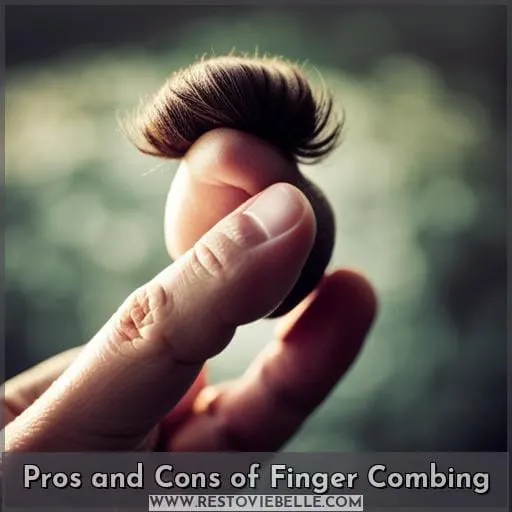This site is supported by our readers. We may earn a commission, at no cost to you, if you purchase through links.
 Are you apprehensive about getting your fingers stuck in tangles? Don’t be! Finger combing natural hair is a great way to protect strands from breakage and promote healthy growth. While it may seem like more work, using just your hands can give you the same results as a comb – without pain or extra damage.
Are you apprehensive about getting your fingers stuck in tangles? Don’t be! Finger combing natural hair is a great way to protect strands from breakage and promote healthy growth. While it may seem like more work, using just your hands can give you the same results as a comb – without pain or extra damage.
We’ll cover all of the basics of finger detangling, including tips on how to use this method correctly and what products are best for finger combs. Plus, we’ll compare finger combs versus traditional combs so that you can decide which works better for your hair texture type.
So put away those worries and get ready to learn about how rewarding (and easy!) caring for curls with just your fingertips can be!
Table Of Contents
- Key Takeaways
- What is Finger Combing?
- What Are the Pros of Finger Combing?
- What Are the Cons of Finger Combing?
- How to Finger Detangle Your Natural Hair
- Finger Combing Vs Using a Comb
- Products for Finger Combing
- How to Finger Comb Hair for Detangling
- Best Detangler for Finger Combing Natural Hair
- Pros and Cons of Finger Combing
- Frequently Asked Questions (FAQs)
- Conclusion
Key Takeaways
- Reduces breakage by up to 90% compared to combs/brushes
- Adds slip with oils/creams for easier detangling
- Stimulates growth by distributing natural oils
- Gentler on the scalp than brushes; provides a massage-like benefit
What is Finger Combing?
Gently running your fingers through your curls and coils is an effective way to reduce breakage, retain length, and learn the nuances of natural hair textures. Finger combing can help you achieve these goals without causing any additional damage or pain that combs or brushes may cause.
This method also allows for frizz control since it doesn’t pull on individual strands as much as other tools do.
The slip method is key when finger combing in order to avoid tugging at tangles, which can lead to split ends later down the line. Oils and conditioners are essential ingredients for this process; they provide a barrier between knotty sections, making them easier to detach without pulling out hairs from their root follicle, which leads directly into knots management – lessening the chances of forming big matted clumps while detangling! By using gentle tugs working up from mid-shafts towards roots, it helps with proper curl definition all throughout each strand instead of creating flat spots due to brushing against resistance in one direction only (this happens quite often with regular brushes).
Finger combing has many benefits, such as allowing you more control over how much tension there is when tackling tough tangles so your scalp won’t be irritated by too hard pulls during styling sessions, nor will you have difficulty feeling what’s happening underneath those locks.
With practice comes precision, so investing time into mastering this technique pays off tenfold because curly care requires patience – especially if it pertains to avoiding unnecessary breakage caused by incorrect handling methods like using conventional combs/brushes that don’t take texture integrity into account.
In summary, finger combing offers a gentler alternative compared to traditional tools and provides numerous advantages, such as reduced risk of split ends formation, improved curl pattern recognition, and enhanced manageability overall resulting in healthier-looking hair!
What Are the Pros of Finger Combing?
Finger combing is a gentle, effective way of detangling and caring for your hair. It significantly reduces breakage, allowing your curls to grow longer with less pain involved. Additionally, it can help you more easily remove tangles in the hair without risking any damage or discomfort.
Less Breakage
You can reduce breakage in your hair with finger combing. It helps you feel tension in strands before they snap, reducing up to 90% compared to combs and brushes. Use a gentle touch and practice skills for optimal results; conditioner or leave-in adds slip factor for easier detangling of knots.
Take your time instead of yanking out healthy hair – this will minimize breakage as much as possible! With control over shedding, you’ll ensure healthier-looking locks while keeping them tangle-free without damaging tools like scissors or hard brushes.
Hair Growth
Frequent finger combing can help stimulate hair growth and reduce breakage, allowing for healthier locks over time. Wave styling with a gentle scalp massage is an effective way to tame frizz while dry detangling helps remove split ends.
Using oils or creams when finger combing adds slip and reduces further damage, leaving your hair stronger and longer than before.
Easier Tangle Removal
Using your fingers to untangle knots can save your hair from breakage and help it remain healthy. Benefits of finger combing include: 1) reduced tension relief on split ends; 2) better scalp care than traditional brushes or combs; 3) extra slip for brushing technique with less tangling; 4) ability to split knotty hairs with reduced breakage.
Less Painful
By gently gliding your fingers through tangles, finger-combing can be less painful than using a brush or comb. Tugging and mechanical stress from brushing tools can yank healthy hair strands out of their follicles.
Treat your hair with care by applying oil before detangling to reduce the potential for breakage. Finger-combing is gentle on the scalp, providing an additional massage-like benefit as you remove knots without pulling too hard on individual hairs.
What Are the Cons of Finger Combing?
Finger combing is a hair care technique that requires time and practice to master, yet may not be able to completely remove all tangles. If you’re looking for an efficient detangling solution for curly or coily hair, finger combing might seem like the ideal option; however, it comes with its own unique drawbacks.
Time
Often, finger combing takes significantly more time than using a wide-tooth comb or brush – up to three times as long, according to some studies. However, many find that the extra effort pays off with less breakage and better hair health due to its gentler touch.
Finger combing may not be ideal for quickly detangling knots or saving time, but it provides slip-enhancing benefits from natural oils and creams.
Requires Practice
Mastering finger combing takes practice, but the reward of healthy hair is worth it. With time and effort, you can learn how to properly detangle one section at a time with your fingers.
Knowing the dos and don’ts of finger combing will help maintain scalp health as well as prevent breakage or shedding while styling different types of hair textures in various styles.
Practice makes perfect – take some extra minutes each day for techniques like twisting sections after fingering through them or using water on wash days for easy tangle removal.
Regular maintenance pays off: healthier locks without breaking hairs are achievable if done right – so never give up!
Not Able to Remove All Tangles
Even with practice, finger combing may not be able to remove all tangles. This means you might need a helping hand from other tools like dry brushing or detanglers. When using the right slip solutions and gentle handling, tugging and breakage can be minimized when removing knots in curly strands.
Finger combing helps distribute natural oils while also collecting shed hair, which makes it easier to manage over time. However, employing extra effort is necessary as this method does have its limitations.
How to Finger Detangle Your Natural Hair
Finger combing is one of the best ways to care for your natural hair. There are three main methods you can use for finger detangling, including dry hair, lightly sprayed hair, and wash day detangling.
Basics of Finger Combing
You can start styling your natural hair with finger combing, a gentle way to detangle knots and reduce breakage. Separate into sections, then use the pads of your fingers to run through wet or dry hair.
Add slip oils for better knot removal – taming frizz while being gentler on scalp sensitivity than wave brushing or combs. Get creative; try different techniques like twisting sections after detangling! Finger detangling is usually much better than combing due to its ability to minimize breakage and provide more control over tricky tangles.
Three Detangling Methods
There are three detangling methods to gently work through your natural hair: finger detangling, finger combing, and using a wide-tooth comb. Prevent knots by moisturizing with oils or a leave-in/detangler like Kinky Curly Knot Today Natural Leave-In/Detangler.
Finger combing is good for both wavy and curly hair; use creams or sprays for proper slip.
Dry Hair
Frantically finger-tangling your dry hair can feel like a never-ending battle, so slow down and use gentle strokes for the best results!
Section off strands before detangling to prevent tangles from forming.
Use moisturizing oils or treatments to add slip and reduce breakage.
Avoid heat styling as it’ll further dry out your locks.
When combing through curls/coils, opt for a soft-bristled brush over hard ones; don’t let them get too dry either!
To protect scalp care while finger combing, apply light pressure with fingertips instead of pulling at knots harshly – this’ll help keep length intact without damaging delicate strands.
Lightly Sprayed Hair
Gently spray your hair with a detangling solution to make finger detangling easier. Divide it into sections and use a soft brush instead of breakable bristles. When using the best detangler, like the Denman brush, be sure to work gently on your hair.
Wash Day Detangling
On wash day, take your time to detangle your natural hair with your fingers; slowly working through knots like a master puzzle solver. Use proper products for slip: oil, slippery detanglers, and add more water or leave-in conditioner if needed.
Keep scissors handy for stubborn knots and styling tips on dry detangling too! Start at the ends of sections, then move upward to the roots – this will help retain length by minimizing breakage.
Finger Combing Vs Using a Comb
Comparing the two, you may find that finger combing can be a more effective way to detangle your hair than using a comb. Finger combing is gentle on curls and coils, reducing tugging and breakage while allowing for better control through tangles.
| Pros | Cons | Tips |
|---|---|---|
| Less handling & breakage | Hair gets more tangled | Divide into sections |
| Twist sections after finger combing | Use water for easy detangling | Extra gentle when dry |
| Minimally use wide-tooth combs | Opt for soft brushes over hard | Oils/Creams provide slip |
Finger Combing also promotes healthy hair growth as it allows you to learn about different textures in your own mane without the help of any tool or system — just use those fingers! And unlike regular combs/brushes, which are harsh on scalps and cause damage due to excessive pulling or brushing, this method provides natural oils from fingertips, which act like creams providing required slip while gently untangling knots strand by strand.
Products for Finger Combing
Explore the range of products available to help you finger comb your hair more effectively, from wide-tooth combs to soft brushes and oils.
The SALONSOLUTIONS Detangling Comb Huge Size is an ideal choice for those with long, thick hair – its wide rounded teeth won’t break strands and can create volume when blow drying.
If your scalp needs extra care, then opt for a wooden brush like Annie Wave Soft Brush, which has 100% boar bristles designed specifically for sensitive scalps.
For wave styling in particular, this oblong shape will hold locks in place while giving it that desired effect too!
Hair tools also come in different textures, so consider what works best with yours – coarse or fine?
Those blessed with curly tresses should look into clip and file nails, as these are gentle on their delicate texture compared to regular plastic ones found elsewhere.
Whatever product type you choose though, don’t rush through the detangling process as this could lead to breakage or damage if not done carefully.
Keep a healthy curly hair routine by taking time out once every week/monthly depending on how often you wash/style it altogether!
How to Finger Comb Hair for Detangling
Finger combing is an effective technique for detangling hair without causing breakage. When done correctly, it can help reduce tugging and tearing of delicate curls, coils, or waves. However, there are some dos and don’ts that must be followed to ensure the best results.
Dos
You can maximize the benefits of finger combing by following these helpful dos:
- Cleansing Benefits – Wet down strands and use a cleansing agent to remove any product buildup.
- Scalp Care – Take your time when finger combing; it may take longer than regular combs or brushes, but it’s worth it to minimize breakage and protect the scalp from damage. Consider using slip agents like oils and creams for easier movement through tangles without pulling on the hair too much.
- Moisturizing Techniques & Protective Styling – Finger combing allows you to apply product more evenly throughout the strands while also helping enhance and define waves or curls, making protective styling even easier with fewer tools needed! Follow up with moisturizing techniques such as deep conditioning treatments to keep coily/curly textures hydrated, bouncy, soft, and healthy!
Don’ts
Avoid using brushes and combs, as they can be too rough on delicate curls. Instead, use your fingers to gently detangle like a soothing massage. Finger combing is ideal for avoiding knots and minimizing breakage in curly hair.
However, when finger combing, opt for soft brushes over hard ones – natural wooden brushes are the best choice! Be sure to feel tension before strands snap by lightly spraying with water or adding some leave-in conditioner every now and then.
Never detangle between wash days since this can cause more damage than good! Pull sections of hair apart slowly with a ponytail holder after you’re done finger combing to help keep it from getting tangled again overnight.
Best Detangler for Finger Combing Natural Hair
Choose a detangler specifically designed for finger combing natural hair to help minimize breakage and maintain healthy, beautiful curls. The best products are those that provide slip and conditioning properties as you work through tangles, while also being gentle on your delicate strands.
Here are four key elements to consider when selecting the right product:
- Detangling Tips – Look for detanglers with moisturizing ingredients like shea butter or coconut oil, which can help soften coils and reduce knots without weighing down the hair.
- Combing Pros – Choose formulas that contain protective silicones, such as dimethicone, which will coat each strand, ensuring less frizz.
- Combing Cons – Avoid using heavy oils such as mineral oil or petroleum jelly if possible, since these can clog pores, leading to scalp irritation over time.
- Combing Tips – With any type of brush types (especially boar bristles), be sure not only is it designed specifically for curly/coily textures but also has soft bristles so it won’t tug at strands, causing them unnecessary damage while still effectively distributing product throughout the entire head evenly.
By following these guidelines when choosing a detangler tailored just right towards finger combing natural hair styles, you’ll be able to achieve optimal results every single time, no matter what type of curl pattern you may have!
Pros and Cons of Finger Combing
Understanding the pros and cons of finger combing is essential to maintaining healthy natural hair. With it, you can reduce breakage by up to 70% compared to using a brush or comb. Finger detangling has become increasingly popular as more people learn how beneficial it can be for their curls, coils, and kinks.
It’s gentler than combs or brushes and provides users with more control while feeling through tangles, which reduces tugging that could lead to breakage.
However, there are also some drawbacks associated with this technique. Knots can form over time due to shed hairs staying tangled in the strands. Plus, it takes longer than using a tool like a wide-tooth comb, so patience is important! To maximize its benefits, use conditioner for slip when wet detangling in sections.
With practice comes mastery, so never give up on perfecting your finger detangling skills.
Frequently Asked Questions (FAQs)
What products should I use when finger combing?
To achieve the best results when combing your hair, use a wide-tooth detangling comb and an Annie Wave Soft Brush. The former gently removes knots while the latter adds volume to create a beautiful wave look.
Is finger combing suitable for all hair types?
Finger combing can be suitable for all hair types, but it depends on the individual. It takes practice to master and may not remove all tangles. For best results, use conditioner or leave-in with water for slip; pre-detangle before using tools if short on time; divide into sections and twist each one after detangling.
Does finger combing work better than a comb?
Finger combing may be more effective than a comb, depending on the hair type. It’s gentler and can help reduce breakage, but it takes time and practice to master. Curly or coily hair textures benefit most from this technique in terms of length retention and feeling tension before strands snap.
How often should I finger comb my hair?
Finger comb your hair as often as needed to maintain its health and beauty. Detangle gently from ends to roots, using conditioner or leave-in for slip. Take your time and keep scissors on hand if necessary. Pre-detangling can save time when short on it, but dry or damaged hair may require extra care.
Is finger combing better than brushing?
Finger combing can be better than brushing as it is gentler on fragile hair, allowing for more control when detangling and minimizing breakage. It requires patience and practice to master, but the rewards are worth it, providing lasting benefits such as reduced damage and improved scalp health.
Conclusion
With finger combing, you can give your natural hair the extra TLC it needs to retain its health and length. Finger combing your hair is less damaging than using a comb or brush, and it helps reduce breakage.
While it may take more time than combing or brushing your hair, the results are worth it.
According to a study, finger combing your hair can reduce breakage up to 80%, making it a clear winner when it comes to protecting your strands. With the right products to provide slip and some practice, finger combing can be an effective way to detangle your natural hair.
So, next time, give your hair the love it deserves and finger comb your way to healthier, longer hair.
